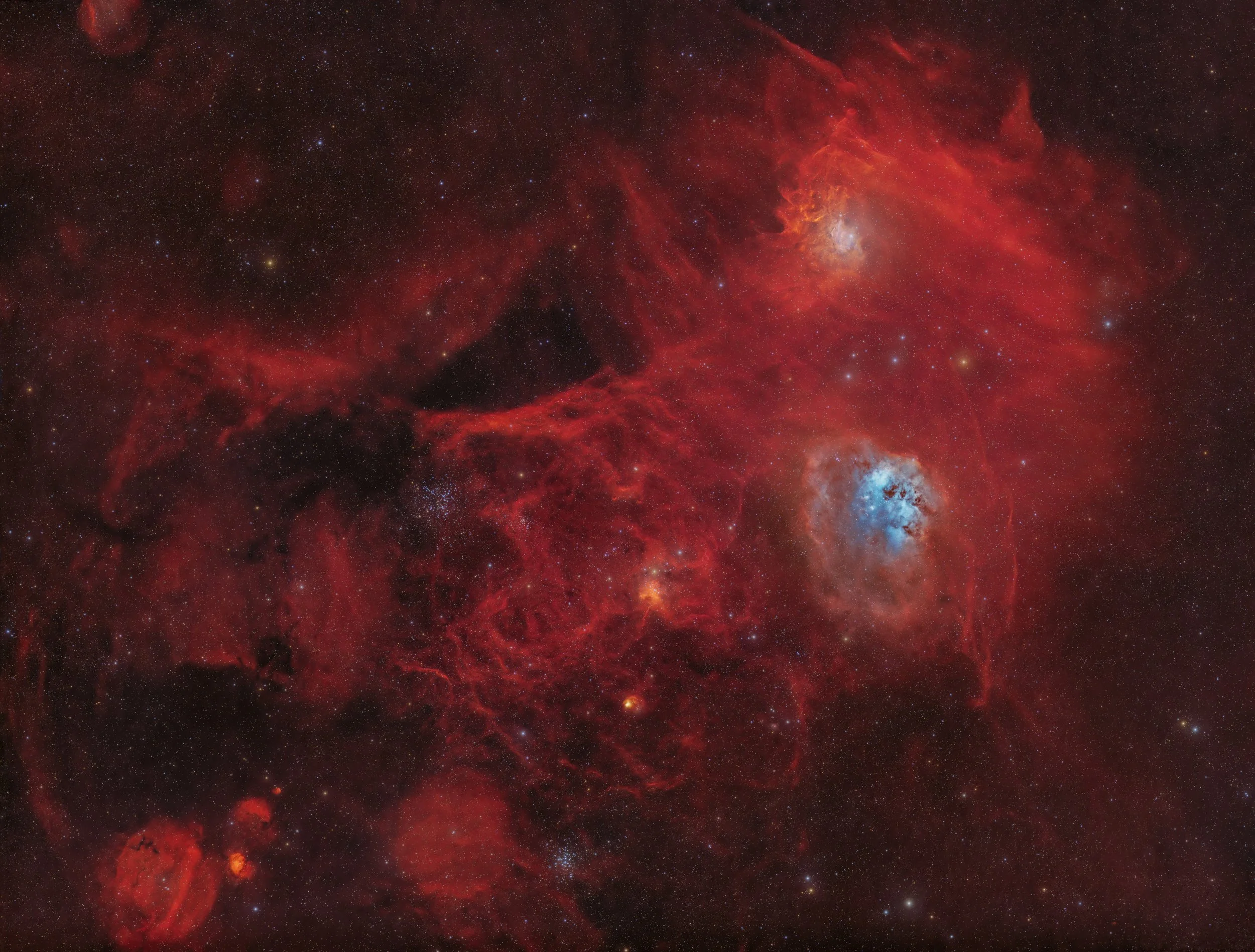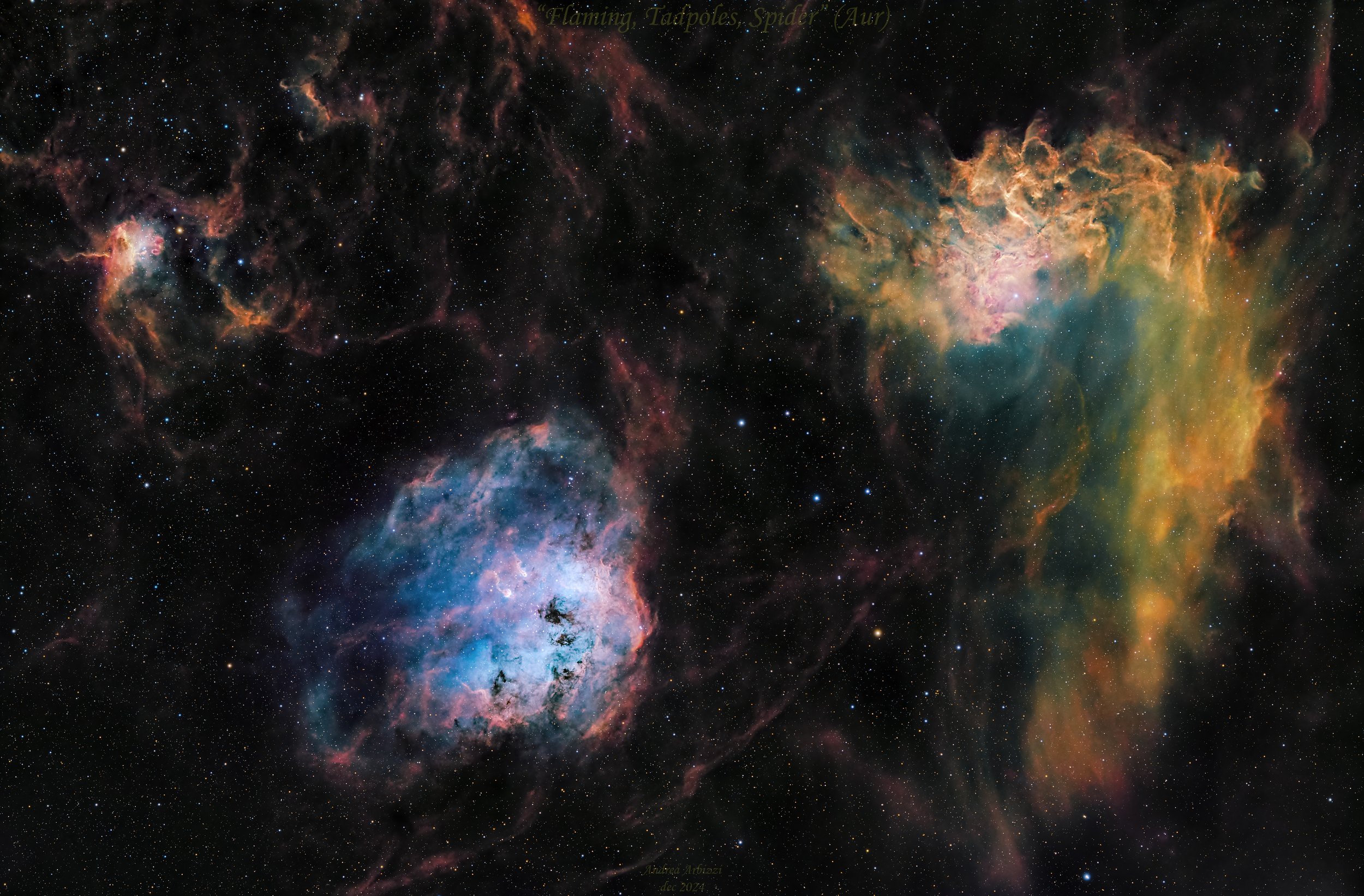
AAPOD2 Image Archives
Auriga's Heartbeat: Nebulae and an Ancient Cluster
his vibrant wide-field image captures two prominent emission nebulae in the constellation Auriga: the Flaming Star Nebula (IC 405) and the Tadpole Nebula (IC 410). IC 405 glows with the intense light of the hot star AE Aurigae, which energizes surrounding hydrogen gas, creating a fiery appearance. Nearby, IC 410 houses the "tadpoles"—dense, dusty structures sculpted by stellar winds from the young cluster NGC 1893.
The image combines over 20 hours of integration using both narrowband and broadband filters. The result is a richly detailed view blending structure, color, and contrast—highlighting the dynamic interplay of ionized gases and star formation within these celestial clouds.
Flaming star, Tadpole and Spider” nebulae
Flaming Star, Tadpole, and Spider Nebulae
In the heart of the winter Milky Way, the Flaming Star (IC 405), Tadpole (IC 410), and Spider (IC 417) nebulae form a mesmerizing trio of emission and reflection nebulae in the constellation Auriga. These celestial marvels lie between 10,000 and 12,000 light-years away, offering a glimpse into the interplay of star formation and interstellar gas. The Flaming Star Nebula, energized by the bright star AE Aurigae, combines glowing hydrogen gas and blue reflection nebulae in a captivating display. Meanwhile, IC 410, home to the “Tadpoles,” showcases dense star-forming regions resembling their namesake creatures, shaped by stellar winds.
The Spider Nebula, IC 417, appears entwined with its companion, the Fly Nebula (NGC 1931), in a delicate dance of gas and dust illuminated by young, massive stars. Observed under light-polluted skies in Modena, Italy (SQM 18.4–18.8, Bortle 7.5–8), these nebulae challenge astrophotographers with their faint, intricate structures. Yet even here, the brilliance of this cosmic trio reminds us of the dynamic processes shaping the Milky Way, bridging vast distances with their light.
Flaming Star to Simeis 147
Image Description and Details :
This image shows the area of sky above the constellation of Orion. In the top right, looking like a comma is the Flaming Star Nebula. Just to the left of it is the Tadpole Nebula. If you look at the high resolution image on my website you can see the tadpole shaped structures inside it that give it its name. To the upper left is Sharpless 232 which I always think looks like a person running in a hamster wheel! To the bottom left is the large supernova remnant Simeis 147 aka the Spaghetti Nebula. This is a 16 image mosaic taken at a focal length of 530mm with a 4 inch refractor. 171 hours of light was collected through H-alph, SII and OIII filters.
Copyright: Alistair Symonu
IC410 - The Tadpoles
Image Description and Details :
The Tadpole nebula or IC 410 is an emission nebula in the constellation Auriga. It lies approximately 12,000 light years from earth.
I don't believe its name needs any explanation, it's one of the few I can see immediately, and I've always struggled with most. This nebula reminds me of a line in one of my favorite songs. "We're just 2 lost souls swimming in a fish bowl". Of course Pink Floyd isn't everyone's thing!
equipment:
Orion RC 8" with CCD47
ZWO ASI 1600MM (-20, gain 139)
Altair 70mm guide scope and ZWO ASI 224 MC
Skywatcher EQ6-r
Integration:
HA - 67x 600 sec
OIII - 5x 600 sec
SII - 5x 600sec
Copyright: Carl Gough
Tadpoles and Flaming Star Nebulae
Image Description and Details :
The Tadpoles Nebula (IC410) and Flaming Star Nebula in the Constellation of Auriga.I took this HaSHO image last week on a very rare almost clear night. In fact it was the clearest night in northern Vermont since last July!. Rather than completing some earlier projects I thought I’d shoot something entirely new, and go for these subjects as they (almost) fit on the same frame at 620mm focal length..The Tadpoles Nebula is so called due to the two light colored tadpole shaped dust and gas clouds that look like they are swimming upwards to the center of the nebula. These are star forming regions, similar to the famous “Pillars of creation” imaged by Hubble in the Eagle Nebula.To get an idea of scale each tadpole is 10 light years long!, more than twice the distance the earth is from its nearest stellar neighbor, Proxima Centauri.To the left is the Flaming Star nebula ( IC 405) which surrounds the variable star AE Aurigae. AE Aurigae is a “runaway” star ejected from gravitational perturbations in the Orion Nebula more than 2 million years ago.Its interesting to note that although these two nebulae appear close together the flaming star is 1500 Light years distant, whereas the Tadpoles Nebula is 12,000 lightyears away and over 100 light years across.This image is processed in the “Hubble Palette where red is aligned with Sulphur emissions, Green with Hydrogen , and Blue with Oxygen .Tech Data : Celestron RASA 11”, CGX Mount, ZWO ASI 6200MMPro cooled (Mono) camera.Ha 12 x 5min, OIII 18 x 5 mins, SII 9 x 5 mins, darks, flats, bias framesSoftware: Stacked in DSS, Processed in Pixinsight and PS 2021
Copyright: Richard Whitehead
Emerald Comet Visits Colorful Auriga
Image Description and Details :
Comet C/2020 M3 Atlas in emerald green color passes by the main colorful nebula of the Constellation Auriga in this image captured and processed from Grand Mesa Observatory on 12/8/2020 by Terry Hancock and Tom Masterson. This image was captured using QHYCCD’s latest offering the QHY410C Back Illuminated Full Frame one shot color CMOS camera that we have the honor of testing. The main nebulae in this image are the Flaming Star Nebula (IC 405) the comma shaped red and white/purple nebula to the top and right along with the Tadpole Nebula (NGC 1893) located to the center left. Comet C/2020 M3 Atlas is seen almost ‘touching’ the Tadpole Nebula in this image. Distance-wise Comet C/2020 M3 Atlas was a mere 3.74 light-minutes from Earth when this image was captured while the Flaming Star Nebula is about 1,400 light-years distant and further still is the Tadpole Nebula which is roughly 12,400 light-years away. Technical Info:Total Integration time 3.3 hours Location: Grand Mesa Observatory.com Purdy Mesa, Colorado
Date of capture: December 9th, 2020Color RGGB 200 min, 100 x 120 sec Camera: QHY410C Back Illuminated Full Frame Color CMOS Gain 0, Offset 76Read Mode: High Gain Mode Calibrated with Dark, Bias and Flat Frames Optics: Takahashi E-180 Astrograph Image Acquisition software Maxim DL6Pre-Processed in Pixinsight Post Processed in Photoshop
Copyright Information: Terry Hancock and Tom Masterson








